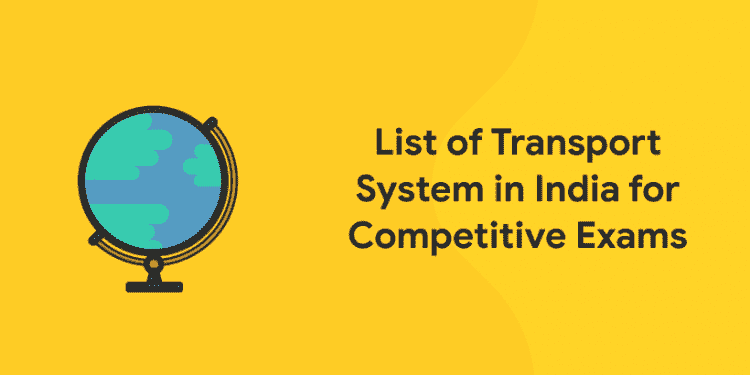Transport or transportation is the movement of humans, animals, and goods from one place to another. Transportation system includes air, land (rail and road), water, cable, pipeline, and location. Mobility is fundamental to economic and social activities such as commuting, manufacturing or supplying energy. Each movement has an origin, a potential set of intermediate locations, a destination and a nature which is linked with geographical attributes. In this article, we have provided list of transport system in India important for competitive exams.
Indian geography represents a multipurpose transport network. Highways, railways, airways, and waterways feature as its predominant transportation networks in India to ferry goods and people in, around, and across the country.
List of Transport System in India
Railway Transport System in India
Rail services in India, first introduced in 1853, are provided by the state-run Indian Railways, under the supervision of the Ministry of Railways. Indian Railways provides an important mode of transport in India, transporting over 18 million passengers and more than 2 million tons of freight daily across one of the largest and busiest rail network in the world.
Transportation of goods and passengers on rail lines through trains is called rail transport. Rail transport occupies an important place in land transport system of our country and is the most dependable mode of transport to carry goods and passengers over a long distance safely.
- The railway was introduced in India in 1853 when a line was built from Bombay to Thane covering a distance of 34 kilometers.
- The total length of the Indian railway network is 64460 km. (March 2011).
- The gauge-wise route and track length system as on 31 March 2007 are as follows: –
- The network is divided into 16 zones. The divisions are the basic operating units. The 16 zones are their respective headquarters which are given below.
Railway Zones in India
Indian Railway is a reputed and one of the largest organizations in India. It is spread throughout the country. So, to ensure smooth functioning and manage the organization effectively, it has been divided into zones that are further divided into divisions.
Each division has its own divisional headquarter. As of now, there are 18 railway zones and 70 divisions in India. The head of each division is Divisional Railway Manager (DRM) who reports to the General Manager (GM) of the railway zone.
Railways Zones and Headquarters
| Zone | Headquarters | Divisions |
|---|---|---|
| 1. Central | Mumbai | Mumbai(CST), Bhusawal, Nagpur, Pune |
| 2. Western | Mumbai | Mumbai(Central),Vadodara, Ratlam, Ahmedabad, Rajkot, Bhavnagar |
| 3. Northern | Delhi | Ambala, Delhi, Lucknow, Moradabad, Ferozpur |
| 4. Eastern | Kolkata | Asansol, Howrah, Malda, Sealdah |
| 5. Southern | Chennai | Chennai, Madurai, Palghat, Trichy, Trivandrum, Salem |
| 6. East Central | Hajipur | Danapur, Dhanbad, Mughalsarai, Samastipur, Sonpur |
| 7. East Coast | Bhubaneshwar | Khurda Road, Sambalpur, Waltair |
| 8. North Central | Allahabad | Allahabad, Agra, Jhansi |
| 9. North Eastern | Gorakhpur | Lucknow, Izzatnager, Varanasi |
| 10. North East Frontier | Guwahati | Katihar, Alipurduar, Rangiya, Lumding, Tinsukia |
| 11. North Western | Jaipur | Ajmer, Bikaner, Jaipur, Jodhpur |
| 12. South Central | Secunderabad | Hyderabad, Nanded, Secunderabad |
| 13. South East Central | Bilaspur | Bilaspur, Nagpur, Raipur |
| 14. South Eastern | Kolkata | Adra, Chakradharpur, Kharagpur, Ranchi |
| 15. South Western | Hubli | Bangalore, Hubli, Mysore |
| 16. South Coastal | Visakhapatnam | Guntakal, Guntur, Vijayawada |
| 17. West Central | Jabalpur | Bhopal, Jabalpur, Kota |
| 18. Kolkata Metro | Kolkata | Not applicable |
Road Transport System in India
Road transport is the second important mode of transport in India. It covers every corner of the country which the railway transport even could not cover. Road transport provides the basic infrastructural facilities to both the agricultural and industrial sector of the country.
- With a total length of approximately 42.3 lakh km, India has one of the largest road networks in the world. 85% of passengers and 70% of freight traffic is carried by roads.
- Roads are classified as National Highways (NH), State Highways (SH), Major District Roads and Rural Roads.
- The National Highways Authority of India (NHAI), an autonomous body under the Ministry of Surface Transport, was operational in 1995. NHAI is responsible for the development, maintenance, and operation of national highways.
- The national highway is only 1.50 percent. Total road length, but about 40 percent of road traffic.
- State highways are constructed and maintained by state governments.
- There are more than 200 National Highways in India. The routes usually range from North-South & East-West.
- The first National Highway in India is NH-1. It links the National capital Delhi to Attari in Punjab near Indo-Pak Border.
- The longest National Highway in India is NH-44. It covers the range from Srinagar to Kanyakumari(North-South Corridor) with a length of approximately 3700km.
List of National Highways in India
The list of major highways in India with their routes and distance is given below:
| Name of the Highway | Length of the Highway/ Distance | Route |
| NH-1 | 663 | Jalandhar-Uri |
| NH-1A | 456 | New Delhi-Ambala-Jalandhar-Amritsar |
| NH-2 | 1465 | Delhi-Mathura-Agra-Kanpur-Allahabad-Varanasi-Kolkata |
| NH-3 | 1161 | Agra-Gwalior-Nasik-Mumbai |
| NH-4 | 1235 | Thane & Chennai via Pune |
| NH-5 | 1533 | Kolkata-Chennai |
| NH-6 | 1949 | Kolkata-Dhule |
| NH-7 | 2369 | Varanasi- Kanyakumari |
| NH-8 | 1428 | Delhi-Mumbai-(via Jaipur, Baroda and Ahmedabad) |
| NH-9 | 841 | Mumbai-Vijayawada |
| NH-10 | 403 | Delhi-Fazilka |
| NH-11 | 582 | Agra-Bikaner |
| NH-12 | 890 | Jabalpur-Jaipur |
| NH-13 | 691 | Sholapur-Mangalore |
| NH-14 | 306 | Morgram-Kharagpur |
| NH-15 | 1526 | Pathankot-Samakhiali |
| NH-16 | 1448 | Kharagpur- Chennai |
| NH-17 | 1269 | Panvel-Edapally |
| NH-18 | 359 | Gobindpur-Balasore |
| NH-19 | 240 | Ghazipur-Patna |
| NH-20 | 658 | Bakthiyarpur-Panikholi |
| NH-21 | 262 | Jabalpur-Agra |
| NH-22 | 459 | Ambala-Shipkitr |
| NH-25 | 353 | Barmer-Beawar |
| NH-26 | 551 | Raipur- Vizianagaram |
| NH-27 | 3507 | Porbandar- Silchar |
| NH-28 | 570 | Lucknow-Barauni |
| NH-30 | 2040 | Sitarganj- Ibrahimpatnam |
| NH-31 | 1125 | Barhi-Guwahati |
| NH-32 | 314 | Chennai-Nagapattinam |
| NH-33 | 443 | Farakka-Arwal |
| NH-34 | 1426 | Gangotri Dham- Lakhnadon |
| NH-37 | 356 | Sutarakandi- Bhali |
| NH-40 | 424 | Kurnool-Ranipet |
| NH-43 | 806 | Katni-Chandil |
| NH-44 | 3745 | Srinagar-Kanyakumari |
| NH-47 | 1080 | Bamanbore-Nagpur |
| NH-48 | 2807 | Delhi-Chennai |
| NH-49 | 440 | Kochi-Dhanushkodi |
| NH-50 | 260 | Bidar-Hospet |
| NH-52 | 2317 | Sangrur-Ankola |
| NH-53 | 1781 | Hajira – Paradip Port |
| NH-58 | 538 | Badrinath – Ghaziabad |
| NH-61 | 652 | Bhiwandi – Nirmal |
| NH-62 | 748 | Abohar – Pindwara |
| NH-65 | 841 | Pune – Machilipatnam |
| NH-66 | 1622 | Kanyakumari – Panvel |
| NH-67 | 432 | Hubli – Gooty |
| NH-75 | 533 | Bantwal – Vellore |
| NH-81 | 340 | Coimbatore – Bengaluru |
| NH-85 | 413 | Cochin – Tondi point |
| NH-105 | 67 | Pinjore – Swarghat |
| NH-150 | 700 | Aizawl – Kohima |
| NH-200 | 740 | Raipur – Chandikhal |
| NH-205 | 442 | Ananthpur – Chennai |
| NH-209 | 456 | Dindigul – Bengaluru |
| NH-211 | 400 | Solaphur – Dhule |
| NH-217 | 508 | Raipur – Gopalpur |
| NH-220 | 265 | Kollam – Teui |
Waterway Transport System in India
Inland Waterways Cheapest means of transport. India has 14, 500 km of navigable waterways.The Inland Water Ways Authority of India was set up in 1986 for the regulation, maintenance and development of National Waterways.
- There are three National waterways in the country: NW 1: Allahabad to Haldia -1620 km. NW 2 : Sadiya to Dhubri (Brahmaputra) 891km. NW 3 :Tottapuram to Kollam (west coast canal) 205 km. -Apart from these three ten other waterways have been proposed.
- Water transport can be divided into two major categories – inland waterways and ocean waterways.
- The Inland Waterways Authority was established in 1986 to develop, maintain and regulate national waterways in the country.
- Ocean transport is the most important water transport because it has some advantages. The sea offers a ready-made carriageway for ships that, unlike a road or railway, do not require maintenance.
- The surface of the water is two-dimensional and, although ships going to sea often have lanes to keep, ships can travel in any direction within a limited number of obstacles.
The major waterway connectivities in India are as follows:
| Inland Waterways Number | Linkages |
| 1 | Ganga- Bhagirathi- Hooghly river system |
| 2 | Sadiya-Dubri stretch in Brahmaputra river system |
| 3 | West coast canal- Champakara canal- Udyogamandal canal |
| 4 | Kakinada- Godavari- Krishna river system |
| 5 | Talcher- Paradip in Odisha |
| 6 | Lakhipur- Banga- Barak river system (proposed) |
Airports Transport System in India
International Airports in India and domestic airports in India are administered by Airport Authority of India (AAI). Airport Authority of India (AAI) provides for safe efficient air traffic and aeronautical communication services in the India Air Space. The Authority manages 11 international and 112 domestic Airports.
- Air transport in India began in 1911 with the introduction of Airmail at a distance of 10 km between Allahabad and Naini.
- Airport Authority of India (AAI) is controlled by the Ministry of Civil Aviation.
- AAI is responsible for managing, upgrading and maintaining the civil aviation infrastructure in India.
- AAI provides service of Air Traffic Management in Indian airspace locations.
- Airport Authority of India not only controlling the International and domestic airports it also controls the Customs airports and Civil enclaves at military bases.
- Hardeep Singh Puri is the Minister of Civil Aviation in India.
- The coastline of India is located with 12 major ports and around 200 non-major ports.
- Major ports are under the purview of the center while non-major ports come under the jurisdiction of the respective state governments.
- Indira Gandhi International Airport is the largest International airport constructed in 5495 acres. It is also the busiest airport in India followed by the Chhatrapati Shivaji International Airport.
- Cochin International Airport, Kerala is the first international airport in India developed under PPP- Public-Private Partnership Model.
- Calicut International Airport, Kerala is recently added to the list of International Airports in India.
- Juhu Aerodrome, Mumbai is the First and oldest Airport in India founded in 1928
- Airport of Trichy is the smallest airport in India.
- Kushok Bakula Rimpochee, Ladhak is the 23rd highest commercial airport in the world at 3256 meters.
International Airports in India
The table given below mentions the list of International Airports in India and the type or purpose these airports are used for.
| International Airport Name & Code | International Airport Location | Type/Purpose |
| Chhatrapati Shivaji International Airport – BOM | Mumbai, Maharashtra | Commercial Airport |
| Kempegowda International Airport – BLR | Bangalore, Karnataka | Commercial Airport |
| Chennai International Airport – MAA | Chennai, Tamil Nadu | Commercial Airport |
| Netaji Subhas Chandra Bose International Airport – CCU | Kolkata, West Bengal | Commercial Airport |
| Chaudhary Charan Singh International Airport – LKO | Lucknow, Uttar Pradesh | Commercial Airport |
| Sri Guru Ram Dass Jee International Airport – ATQ | Amritsar, Punjab | Commercial Airport |
| Visakhapatnam International Airport – VTZ | Visakhapatnam, Andhra Pradesh | Civil Enclave |
| Kannur International Airport – CNN | Kannur, Kerala | Commercial Airport |
| Surat International Airport – STV | Surat, Gujarat | Commercial Airport |
| Devi Ahilya Bai Holkar Airport – IDR | Indore, Madhya Pradesh | Commercial Airport |
| Cochin International Airport – COK | Kochi, Kerala | Commercial Airport |
| Sardar Vallabhbhai Patel International Airport – AMD | Ahmedabad, Gujarat | Commercial Airport |
| Indira Gandhi International Airport – DEL | Delhi | Commercial Airport |
| Dabolim Airport – GOI | Goa | Civil Enclave |
| Pune Airport – PNQ | Pune, Maharashtra | Civil Enclave |
| Thiruvananthapuram International Airport – TRV | Thiruvananthapuram, Kerala | Commercial Airport |
| Coimbatore International Airport – CJB | Coimbatore, Tamil Nadu | Commercial Airport |
| Calicut International Airport – CCJ | Calicut, Kerala | Commercial Airport |
| Biju Patnaik International Airport – BBI | Bhubaneswar, Odisha | Commercial Airport |
| Lokpriya Gopinath Bordoloi International Airport – GAU | Guwahati, Assam | Civil Enclave |
| Lal Bahadur Shastri International Airport – VNS | Varanasi, Uttar Pradesh | Commercial Airport |
| Rajiv Gandhi International Airport- HYD | Hyderabad, Telangana | Commercial Airport |
| Tiruchirappalli International Airport – TRZ | Tiruchirappalli, Tamil Nadu | Commercial Airport |
| Dr. Babasaheb Ambedkar International Airport – NAG | Nagpur, Maharashtra | Commercial Airport |
| Sheikhul Aalam International Airport – SXR | Srinagar, Jammu and Kashmir | Civil Enclave |
| Imphal International Airport – IMF | Imphal, Meghalaya | Commercial Airport |
| Jaipur International Airport – JAI | Jaipur, Rajasthan | Commercial Airport |
| Madurai Airport – IXM | Madurai, Tamil Nadu | Customs, Commercial |
| Bagdogra International Airport – IXB | Siliguri, West Bengal | Commercial Airport |
| Jay Prakash Narayan International Airport – PAT | Patna, Bihar | Commercial (Restricted International Flights, Customs) |
| Mangalore International Airport – IXE | Mangalore, Karnataka | Commercial Airport |
| Chandigarh International Airport – IXC | Chandigarh | Civil Enclave (Restricted International Flights, Customs) |
Seaport Transport System in India
Around 95% of the trading (by volume) and 70% of the trading (by value) is done by maritime transport as per the Ministry of shipping. There are 12 Major seaports in India in which 11 are government-owned and one is private. These posts are governed by the central government while the minor and intermediate ports are governed by the state governments. There are 187 non-major ports in India governed by nine coastal states.
- The 12 major ports handled about 71 percent of the country’s maritime traffic in the year 2008-09.
- Mumbai has a natural harbor and is the largest port in the country line pipe
- The oil and gas industry in India imports 82% of its oil needs and aims to bring it to 67% by 2022 with local exploration, renewable energy, and indigenous ethanol fuels (January 2018).
- The length of pipelines for crude oil is 20,000 km (12,427 mi).
- The length of the petroleum products pipeline is 15,000 kilometers (9,300 mi).
List of Major Sea Ports in India
| Name of the Port | Name of the State |
| Deendayal Port Trust | Gujarat |
| Paradip Port Trust | Odisha |
| Jawaharlal Nehru Port Trust | Maharashtra |
| Mumbai Port Trust | Maharashtra |
| Visakhapatnam Port Trust | Andhra Pradesh |
| Chennai Port Trust | Tamil Nadu |
| Kolkata Port Trust | West Bengal |
| New Mangaluru Port Trust | Karnataka |
| V. O. Chidambaranar Port Trust | Tamil Nadu |
| Kamarajar Port Limited | Tamil Nadu |
| Kochi Port Trust | Kerala |
| Mormugao Port Trust | Goa |
The space transport system in India
- The Space Transportation System(STS) also known internally as the Integrated Program Plan(IPP) to NASA. It was proposed in 1969 reusable human-vehicle vehicles to support expanded operations beyond the Apollo program. Was the system.
- Firstly, the purpose of the system was two fold: to reduce the cost of spaceflight by changing the current method of launching capsules on spendable rockets with reusable spacecraft; And to support ambitious follow-on programs, including permanent orbiting space stations around Earth and the Moon, and a manned landing mission to Mars.
- The country’s first spaceport is located at Sriharikota in Andhra Pradesh, about 90 km northeast of Chennai.
- India’s second spaceport for launching small satellites would be located in Tamil Nadu’s Thoothukudi district.













